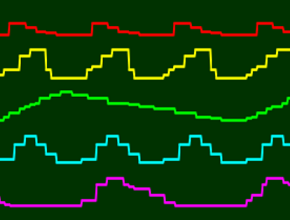Table of Contents
Introduction
Click on the button below to download the .voltagepreset file then open it to launch Voltage Modular with the patch ready built.

Although this patch produces just a rather crude loop without a proper start or end, it’s still kind of interesting and almost elegant in its simplicity. It really needs a properly crafted introduction or at least a fade in as the rhythm sounds clumsy when you first start it up, but give it a minute and it settles down as your brain picks up the off-kilter looping patterns.
It relies on the fact that the raw triangular waveforms of the Vintage Oscillator module sound reasonably palatable without any filtering. It also avoids the need for Sample & Hold modules because the envelopes are all so short (we’ll discuss adding S&H later).
It shows a couple of the ways that the AHR Generator can be used. In this case as pitch contour generators that trigger roughly once per bar and as envelope generator/VCA mechanisms that trigger once per note.
Musically there’s very little going on as it’s just a single fixed chord (a Cm9) but it would be pretty straightforward to add a chord progression. The idea behind this patch is to demonstrate a generative technique that you might use for just one layer of a much larger composition.
There are five very simple voices, four producing triangular waveforms and a fifth that uses filtered noise as a sort of percussion effect.
Three Song Parts are used with slightly different V/Bar wiring so that some voices drop out for eight bars. In Part A the magenta color-coded voice is absent. In Part B the yellow one. In Part C the white one. You never get to hear all five voices together.
This is a very useful technique in composition – what’s not there is sometimes more important that what is.
The probability settings of some of the Rhythm Sequencers are turned down slightly to add a little random variation but without it being too obvious.
Individual voices
Let’s take a closer look at one of the voices…
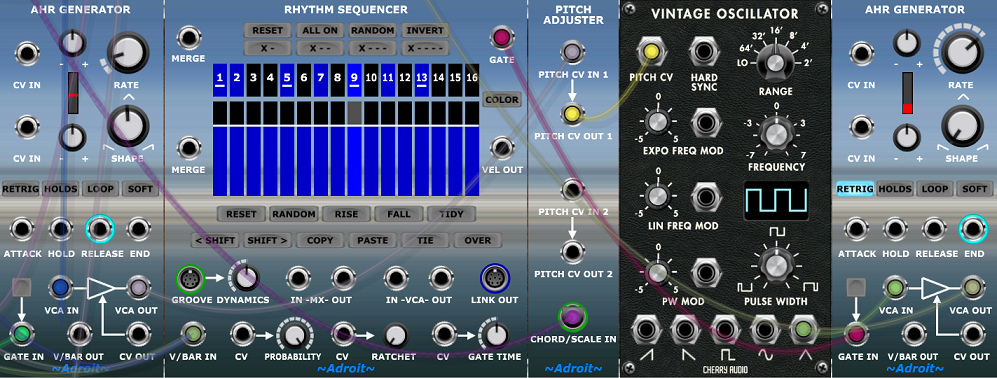
The AHR Generator on the left is triggered by the BAR OUT signal from the Song Control module. The AHR Generator’s RATE and SHAPE controls for this particular voice are set so that it produces a triangular output that lasts less than a bar.

Note that because the RATE settings of the various AHR generators are fixed in this patch, changes in tempo will not automatically scale the timing of the arpeggios.
We want to use the output of this AHR Generator to control the pitch of the oscillator but the CV OUT signal goes from 0 to 5 volts which would produce a crazy five octave range. We could use an Attenuverter module to reduce this voltage but as we have a spare VCA already in place an easier solution is to use the VCA to apply the contour to an external voltage that is the octave range we require. So an Octaves module is included in the patch.
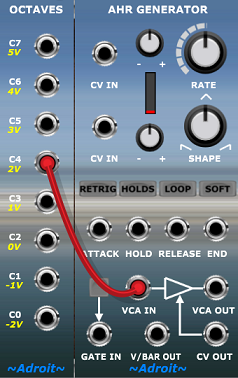
In this voice we want a two octave range so the 2V socket of the Octaves module is patched to the input of the VCA. The output of the VCA now ranges between 0 and 2 volts as required. Note that one of the voices in this patch has just a single octave range so that is fed with the 1V signal from Octaves.
Rather than a siren like sweeping pitch we want the pitch to be one of the notes in the chord. So the VCA OUT signal is processed by one of the pitch quantizers in the Pitch Adjuster module. The Pitch Adjuster’s CHORD/SCALE IN socket being fed from the CHORD OUT socket of the Chord module at the top of the patch.
This turns the diagonal contour from the AHR Generator into a staircase pattern where each step corresponds to a note in the chord. There are five notes in a Minor 9th chord and the contour ranges over two octaves so there are quite a few steps.
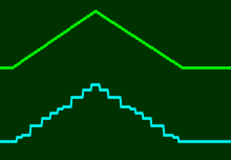
The voice’s Rhythm Sequencer produces a gate pattern that is synchronized with the pitch contour because it’s driven by a V/Bar signal from the same timing source – the Song Control Sequencer.
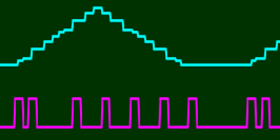
The Rhythm Sequencer’s gate pattern is used to trigger the AHR Generator on the right-hand side of the voice. This AHR Generator has a fast RATE setting and a fast attack SHAPE to create a short plucking envelope.

This envelope is imposed on the triangular wave output from the oscillator by using the AHR Generator’s built-in VCA. The audio signal from the VCA OUT socket is then fed to the mixer at the top of the patch.
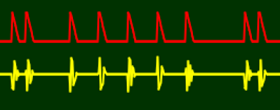
Let’s pull all the control signals for this one voice together so that it’s really obvious what is going on…

Multiple voices
As you have no doubt already figured out, each voice’s pitch contour is different because the AHR Generators have different settings. The image below shows the five pitch contours over a period of several bars…
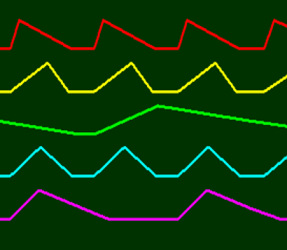
Note that some contours extend beyond a single bar. This is because of RETRIG buttons that aren’t engaged and RATE setting that are relatively slow. When RETRIG is disengaged an AHR Generator won’t retrigger until it has finished its cycle.
Each voice also has a different rhythm pattern…
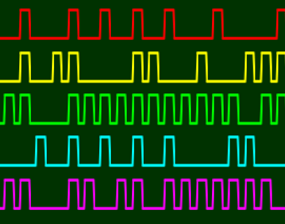
Note to show all five Rhythm Sequencers working at once required a small mod to the patch as normally one of them is dormant.
And slightly different envelopes…

The oscillators are also set up to operate in various different octaves. And of course one of the voices uses filtered noise rather than a triangle wave.
Finally, each voice is panned to a different position in the stereo image.
Sample & Hold
As was mentioned much earlier, this patch gets away with not using sample and hold because the envelopes are all so short that the fact that the pitches are changing a lot behind the scenes isn’t obvious. But if you turn down the RATE knob on some of the AHR Generators (the ones performing the per-note envelope/VCA function on the right-hand side of a voice sub-patch) you will reveal all manner of “excess” notes. This can actually sound quite good but what if you want to have pitches that are more stable and well-behaved?
The answer is to add a Sample & Hold module to each voice. These being triggered by the voice’s Rhythm Sequencer’s gate signal. In this way the varying pitches will be sampled on the onset of a note and remain fixed in pitch until the next note.

It’s not a particularly tricky modification but it adds five more modules and ten more cables to the patch so I decided to relegate it to the end of this workshop.
You can download the modified patch by clicking on the button below…
When you play this version it should sound identical to the one without Sample & Hold modules at first. But when you adjust the envelope RATE settings it responds in a totally different way.
Try lowering the RATE settings on the magenta, yellow or blue color-coded voices and you will find that you can now get long sustained notes without extraneous pitches being introduced. It’s far more musically useful than the patch without the Sample & Hold modules.
The other Rhythm Sequencers have all 16 steps set to on so the effect isn’t so obvious, but if you modify their gate patterns you will hear the same effect.
The image below shows what’s going on with the control signals for a single voice. The red trace shows the quantized pitch voltage before Sample & Hold does it’s job, the yellow trace shows the output of the Sample & Hold module and the green trace shows the gate pattern.
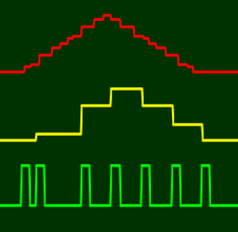
Finally, let’s look at the pitch CV signals for all five voices over several bars when both quantization and sample & hold are applied…
